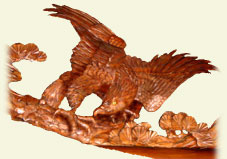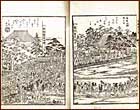|
 |
 |
 |
| The eagle in a sculptured wooden wall |
|
 |
 |
A picture and a wooden statue
of Washimyoken Bodhisattva |
|
|
The temple of Chokoku-ji was established in 1630, in the early years of the Edo period, and it was dedicated to Nichiren, the Buddhist priest who founded the sect that is named after him. Enshrined in the temple is a statue of Washimyoken Bodhisattva, who holds a sword in his right hand and has an aureole incorporating the seven stars of the Great Bear constellation. Familiarly known as Otori-sama among the people of Edo (now Tokyo), the statue stands on the back of an eagle (washi), hence its name, and it is reputed to bring good fortune and prosperity to all people who worship it. |
|
 |
|
The Washimyoken Bodhisattva was unveiled in November on the day of the Tori (Rooster), according to the lunar calendar. The event attracted so many people that an open-air market came into being, and this is the origin of the present Asakusa Tori no lchi (Asakusa Fair of the Rooster) and the reason Chokoku-ji is also known as Tori no Tera (Temple of the Rooster).Held in front of the main gate of Chokoku-ji two or three times each November, the fair prospered during the Edo period together with the adjacent Yoshiwara pleasure quarter. A highly decorated bamboo rake was particularly popular as a charm to bring prosperity in business. |
| A highly decorated bamboo rake |
 |
|
 |
 |
| Landscape of Asakusa Washidai-myojin from Toto illustrative verses. / Many people crowd Temple of Tori in Asakusa on the day of Tori. |
|
|
 |
|
In 1868, after a government ordinance separated Shintoism from Buddhism, one part of Chokoku-ji became Otori Shrine, which holds its own Tori no lchi at the same time as Chokoku-ji's fair.
| The Asakusa Tori no lchi fair is still flourishing today and represents a continuing tradition from the Edo period, when townspeople came to the temple of Chokoku-ji to give thanks for the health and safety of their families and to pray for good fortune and happiness in the year to come. |
|
|
|
|
|